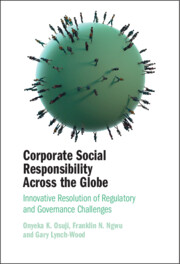 Corporate Social Responsibility Across the Globe
Corporate Social Responsibility Across the Globe Book contents
- Corporate Social Responsibility Across the Globe
- Corporate Social Responsibility Across the Globe
- Copyright page
- Epigraph
- Contents
- Figures
- Table of Cases
- Table of Legislation
- 1 Introduction: The Centrality of Regulation in Corporate Responsibility
- Part I Regulation Concepts, Paradigms and Approaches for Corporate Social Responsibility
- Part II Infusing Corporate Social Responsibility in Corporate Governance
- 5 CSR, Directors and Top Management Officers: Responsibility and Accountability Pathways
- 6 Structural Limits and Structural Opportunities for Shareholder Regulation
- 7 SMEs: An Untapped Platform for Sustainable CSR Penetration and Practice in Developing and Emerging Markets
- Part III Stimulating Private Regulation of Corporate Social Responsibility
- References
6 - Structural Limits and Structural Opportunities for Shareholder Regulation
from Part II - Infusing Corporate Social Responsibility in Corporate Governance
Published online by Cambridge University Press: 15 June 2023
- Corporate Social Responsibility Across the Globe
- Corporate Social Responsibility Across the Globe
- Copyright page
- Epigraph
- Contents
- Figures
- Table of Cases
- Table of Legislation
- 1 Introduction: The Centrality of Regulation in Corporate Responsibility
- Part I Regulation Concepts, Paradigms and Approaches for Corporate Social Responsibility
- Part II Infusing Corporate Social Responsibility in Corporate Governance
- 5 CSR, Directors and Top Management Officers: Responsibility and Accountability Pathways
- 6 Structural Limits and Structural Opportunities for Shareholder Regulation
- 7 SMEs: An Untapped Platform for Sustainable CSR Penetration and Practice in Developing and Emerging Markets
- Part III Stimulating Private Regulation of Corporate Social Responsibility
- References
Summary
Increasing regulatory oversight to control shareholders is bound to underperform. This is because it rests on an invalid assumption, namely that shareholders are better controlled and better steered when regulatory stringency is increased. The assumption runs counter to the conditions that a regulation must require of shareholders, owing to those conditional requirements being unevenly matched by shareholders. Specifically, since shareholders vary in what is required of them by a regulation, the increase of regulatory oversight necessitates that some shareholders will fail to respond, some will comply with what is required, and others will do more. Increasing regulatory oversight does not therefore address the fundamental problem of there being pre-existing deficiencies in stakeholder capacities to comply. To better address the problem, a minmax approach to regulation is proposed. The main benefit of minmax is that it aligns itself to shareholder differences, helping to reduce non-compliance while simultaneously encouraging beyond-compliance behaviour.
- Type
- Chapter
- Information
- Corporate Social Responsibility Across the GlobeInnovative Resolution of Regulatory and Governance Challenges, pp. 132 - 154Publisher: Cambridge University PressPrint publication year: 2023
